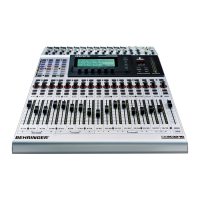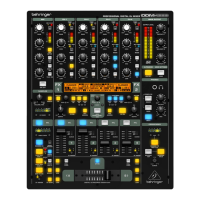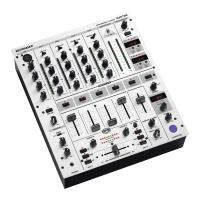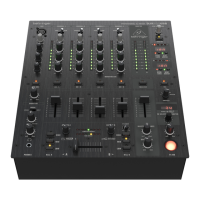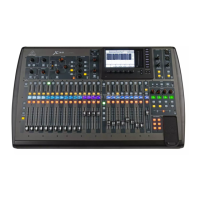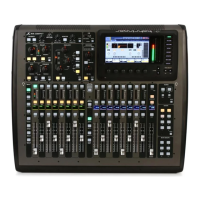49
Use the faders of channels 1-16 to adjust the levels of the
digital recorder tracks, and the pre-fader aux sends of channels
17-32 to provide the monitor mix for the musicians. Connect your
monitor system (e. g. BEHRINGER TRUTH B2031) to the control
room outputs. The MAIN output provides the mix signal for the
2-track master recorder.
15.2 The DDX3216 in live applications
15.2.1 Live recording with the DDX3216
With its flexible routing options, the BEHRINGER DDX3216 is
the ideal tool for live recordings, as you can create separate
FOH and recording mixes with only one console!
First, define the routing for channels 1-16 and 17-32. As the
instruments connected to the analog inputs need to be available
for recording as well, the analog inputs 1-16 are routed to
channels 1-16 and 17-32 (INPUT page in I/O menu). This enables
you to create an independent mix (including equalization and
effects) with the faders of channels 17-32. In the ROUTING
menu, channels 17-32 are sent to the 16 busses of the DDX3216,
from where they are recorded on a multi-track recorder, using
an optional digital interface. In this configuration, the level adjusted
with the faders of channels 17-32 is independent of the level of
channels 1-16.
Such a routing configuration is also suitable for TV applications.
For example, when doing a live TV show, the FOH and TV mixes
are always separate, because the equalization of e. g. clip-on
microphones must be adjusted differently for the P. A. and TV
transmission systems, which is no problem when using the
DDX3216, as this console can be used for both tasks.
15.2.2 Sound reinforcement
As the operation of digital consoles has been anything but
intuitive until now, such consoles have certainly not been
considered the first choice of “P. A. people”. The pioneering
DDX3216 opens up a new dimension in this area, as its
parameters can be operated quickly and intuitively—which is
ideal for sound reinforcement applications. Fader and mute
groups, snapshots and dynamic automation are just some of the
advantages no (affordable) analog console can offer, but which
make the daily routines of P. A. technicians much easier. Below
please find three examples of complex sound reinforcement
applications:
Top-40 band
Top-40 bands must be able to perform a comprehensive and
often quickly changing repertoire. What counts is to be able to
play the latest hits and chart breakers, and having a “good sound”
is a must. Different musical styles require different sounds and
effects. Often, a rock song is followed by a techno or dance hit.
With an analog console, such quick changes are often impossible
to realize—with the DDX3216, problems like these are a thing of
the past, as you can create dedicated snapshots for each song.
These snapshots can be recalled within seconds, including all
stored EQ, dynamics and effect settings. And as it is possible to
recall snapshots via MIDI, you can even control them from a
master keyboard or MIDI sequencer—which is a convenient way
to remotely control your DDX3216.
Music festival
It is your job to manage the sound system for a music festival.
Five bands will be performing on stage, one after the other.
You’ve got 30 minutes to change the equipment on stage, but no
time for sound checks.
The audiences at such a festival are often disappointed
because of the poor sound, which is primarily due to the fact
that it is almost impossible to re-adjust the mixing console and
effect settings in the short period of time between the
performances of two bands. With the DDX3216, however, you
will accomplish this task in the most easy and straightforward
way you could imagine:
As all console parameter can be “frozen” and recalled when
required, you only need a few seconds to re-configure the entire
equipment for a new band entering the stage. For example, in
the run-up to the festival you could agree with each band on
their specific setup, and can pre-program the console
accordingly. Often, the EQ and effects library will be of valuable
help to adjust some basic settings, which can be fine-tuned later
on if need be.
+ By the way: if you need more analog inputs than are
provided by the DDX3216, you can connect external
A/D converters to the digital connectors of the
optionally available interfaces. There are plenty of
solutions available for the digital formats AES/EBU,
ADAT
®
and TDIF. We recommend using external A/D
and D/A converters made by RME.
Musical
Setting the sound for a musical is one of the most demanding
tasks in sound reinforcement. The audience expects to see and
hear a perfect synthesis of sound, light and stage sets. Quick
set changes and a large number of actors and performers require
maximum attention of all people involved. Even minor mistakes
can ruin the entire performance. Often, you have an orchestra
playing and need to cue in various playbacks with timecode
precision. For this purpose, audio engineers, conductor and
performers must be given exact cues for their entries.
The BEHRINGER DDX3216 features pioneering functionalities
for such applications: you can recall snapshots by means of
timecode-based MIDI program changes, so as to accurately
follow any change of stage sets. The dynamic automation allows
for complex mixes, which could otherwise be realized in recording
studios only. Additionally, the director can change audio and
light scenes in parallel via MIDI, and thus give the audio engineers
enough time and opportunity to fine-tune and perfect their mixes.
At last, the era of automated sound reinforcement has begun!
15. APPLICATIONS

